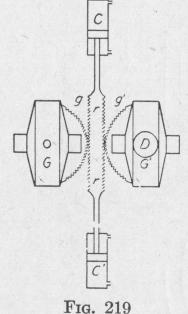270 GYROSCOPIC STABILIZATION
torque is transferred to the attached frame and tends to right the car. The magnitude of this righting torque depends upon the angular momentum of the gyros and the acceleration of their precessional velocity.*
While the keyed roller a' is moving in contact with the shelf d' toward the reader, the other keyed roller a is moving off the shelf d toward the reader. The loose roller now is above the shelf e but not touching it. The righting torque tilts the car to the right beyond the vertical position, thereby causing the shelf e to press upward against the loose roller b. The torque thereby pro
duced causes the roller a to precess away from the reader and to bring it onto the shelf d. At the same time, the gearing moves a' and b' also away from the reader. During this motion neither a' nor b' touches a shelf. This back-and-forth motion of the car is repeated through smaller and smaller amplitudes of oscillation till the car stands upright or till the car is acted upon by another disturbing torque.
Brennan's monorail car of 1916 is provided with a more effective device to control the precessional velocity of the gyros. Since the
velocity of precession is proportional to the torque tending to tilt the car, the righting torque should be proportional to the precessional velocity. Also, the righting torque should be proportional to the length of time that the disturbing torque acts. In Brennan's monorail car of 1916 there is applied about the precession axes of the gyros a torque which, at any instant, is nearly proportional to the velocity of precession, to the angular displacement of the spin-axles from the central position, and to the frictional torque opposing precession.
Figure 219 shows the two gyros, as seen by an observer looking down upon them, spinning in opposite directions about axes normally horizontal and perpendicular to the track, and capable of precessing about vertical axes. Rigidly attached to the gyrocasings G and G' are gear segments g and g'. These gear segments mesh with a double rack r connecting two pistons capable of being
pushed back and forth by air pressure in two cylinders C and C'.
* Eddy, " The Mechanical Principles of Brennan's Monorail Car," J. Franklin Inst. (1910), p. 467.
GYROSCOPICALLY STABILIZED MONORAIL CARS 27
The admission of compressed air into these cylinders and the exhaust from them are controlled by a compound air valve, not shown in the diagram, operated by a device attached to the upper end of the precession axle D of one of the gyros.*
As soon as the car tilts, the spin-axles of the two gyros begin to precess in opposite directions. The rotation of the precession axle of G' causes the attached mechanical device to exert a force on the end of a rod, to the other end of which is a compound air valve connected into the service lines of the servomotor cylinders. This force is the resultant of a force that is proportional to the precessional velocity, to a force that is proportional to the angular displacement of the gyros from their central position, and to the friction around the precessional axes. This resultant force opens the valves of the servomotor to a degree proportional to the force, thereby accelerating the precessional velocity by an amount proportional to the torque that tilted the car from the vertical. This acceleration of the precessional velocity is accompanied by a torque adequate to erect the car if the dimensions of the apparatus are of the proper values. The car is furnished with a device to hold the car upright when the gyros are not spinning.j'
164. The Scherl Duogyro Monorail Car of 1912. - The stabilizing device consists of two gyros, spinning in opposite directions about axes that normally are vertical, and capable of precessing about axes that are transverse to the longitudinal axis of the car. The two gyro-casings are coupled together by a pair of gear segments so that the velocities of precession of the two gyro-axles, at any instant, are equal in magnitude and opposite in direction. There is a motor that accelerates the precession at the proper times. This precession motor is of the hydraulic type, consisting of a cylinder and piston together with a set of valves that are controlled by the rocking movements of the gyro system. Hydraulic pressure is produced by an electrically driven pump. A devicel is provided so that, in case there should be an interruption of the main current that operates the gyro and precession motors, the continued rotation of the gyros will cause the gyro-motors to act as electric generators, the current thereby produced operating the stabilizing system for a considerable time. As soon as the speed of rotation of the gyros falls to such a value that the stability
* U. S. Patent. Brennan, No. 1183530, 1916 f U. S. Patent. Brennan, No. 1019942, 1912
1 U. S. Patent. Falcke, No. 1048817, 1912.
